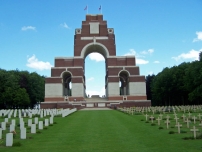| First Name: | Frederick | Last Name: | LIPSCOMBE | |
|---|---|---|---|---|
| Date of Death: | 18/08/1916 | Lived/Born In: | Dalston | |
| Rank: | Lance Corporal | Unit: | Somerset Light Infantry6 | |
| Memorial Site: | Thiepval Memorial, France | |||
Current Information:Born-Dalston
The Battle of the Somme (July-November, 1916) By the beginning of August the Battle of the Somme had been raging for a full month. Thousands of men had already been killed or wounded or were simply missing, never to be seen again and and just a few square miles of the French countryside, all in the southern part of the battlefield, had been captured from the enemy. Mistakes had been made by the various commanders and would be continued to be made but there was no turning back as the British, Australians, South Africans, New Zealanders and Canadians carried on battering away at the German defences in the hope of a breakthrough, So it continued all the way through to November with nearly every battalion and division then in France being drawn into it at some stage. In the end the German trenches had been pushed back a few more miles along most of the line but the cost in lives had been staggering. By the end of the fighting in November, 1916, British Army casualties numbered over 400,000, killed, wounded and missing. After a series of piecemeal, largely uncoordinated attacks against the German line in the first half of August, 1916, some lessons had been learned and the large operation carried out on 18th August at least had the merit of an attack on a broad front with a standard zero hour of 2.45pm. But in other respects, notably the artillery bombardment, tactics had not improved much. The Germans had by now adopted the tactic of placing their machine-guns in isolated shell holes which could only be destroyed by drenching the whole area with artillery but this did not happen and it was going to cost many British lives. The main focus of the attack was against the village of Guillemont but also stretched further along the line as far as High Wood. Despite some gains around Delville Wood and to the north and south of Guillemont, the attack was a failure. The main bastions of the German defence line were not breached. 43 Brigade of 14th Division attacked from out of Delville Wood in a north-easterly direction and with mixed fortunes. On the right 6th Somerset Light Infantry made good progress, advancing close behind a barrage, and found the southern part of Beer Trench and Hop Alley practically obliterated. Here the surviving Germans were only to eager to surrender and many prisoners were taken. 6th Somerset then occupied and consolidated these captured trenches and fought off two subsequent counter attacks. Not so fortunate were 6th Cornwall Light Infantry on the left, who met fierce resistance and were unable to hang on to the initial gains they made. Compared with 6th Cornwall, the casualties sustained by 6th Somerset were light but nevertheless there were men killed and one of them was Frederick Lipscombe. |
||||
| « Back to Search Results | ||||
| If you think any of the information shown here is incorrect, Click Here to submit your amends and comments | ||||




